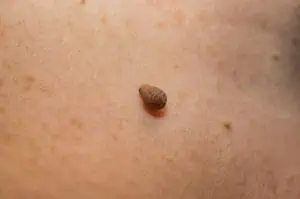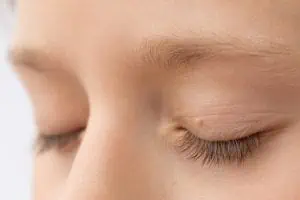 Skin tags are those soft, fleshy growths that protrude from the skin and sometimes hang off it. They’re harmless, but sometimes annoying as they may rub against clothing or get snagged by jewelry. And, let’s face it, if you have a skin tag that’s sitting in plain view, you may get tired of looking at it. In that case, head for the dermatologist, not the drugstore. (And above all, don’t reach for the scissors, nail clippers or a piece of string!)
Skin tags are those soft, fleshy growths that protrude from the skin and sometimes hang off it. They’re harmless, but sometimes annoying as they may rub against clothing or get snagged by jewelry. And, let’s face it, if you have a skin tag that’s sitting in plain view, you may get tired of looking at it. In that case, head for the dermatologist, not the drugstore. (And above all, don’t reach for the scissors, nail clippers or a piece of string!)
What is a skin tag?
Skin tags, technically called acrochordons, are benign skin growths made of collagen fibers, nerve cells, fat cells and a covering of skin. They are usually flesh colored but may be darker. They often start as a small, flat bump. Sometimes they stay that way, but often they begin to slowly protrude from the skin. Skin tags can appear almost anywhere, but they tend to grow in skin folds. Common sites include the eyelids, neck, armpits, groin area and under the breasts.

No one knows exactly why skin tags form, but they’re more common with age, obesity and pregnancy. Friction — from skin rubbing against skin or clothing rubbing against skin — is one possible trigger. Some people may have a genetic predisposition to develop skin tags. It’s possible that insulin resistance might also increase the risk.
There is no medical reason skin tags need to be removed, but if you find them bothersome or unsightly, a dermatologist can get the job done. (Skin tags sometimes fall off on their own, but most don’t.)
Surgical skin tag removal methods
Dermatologists typically use one of three methods to remove skin tags, depending on the size and location of the growth. Small skin tags can often be removed without the use of an anesthetic. You might experience some brief discomfort. If you have a larger skin tag or multiple skin tags, the doctor may apply a topical anesthetic before proceeding.
Excision
Small skin tags that have a stalk or stem, known as pedunculated skin tags, may be removed using a scalpel or sterile surgical blade scissors. Note: These scissors are much sharper than the scissors or nail clippers you have at home — and again, they are sterile, which is very important. The provider might apply a chemical compound prior to removal to decrease bleeding.
Cryotherapy (freezing)
Cryotherapy involves freezing the skin tag with liquid nitrogen, which causes it to fall off, usually within about 10 days. The liquid nitrogen may cause a brief burning sensation.
Cauterization
With cauterization, aka electrocautery, the skin tag is burned off at the base using an electric current. This simultaneously removes the skin tag and seals the wound to prevent infection and bleeding.
Why you shouldn’t remove a skin tag at home
Some people try to remove skin tags at home using scissors or nail clippers, but those efforts can go wrong very quickly. Even using an over-the-counter product to remove skin tags is not ideal. Here’s why it pays to leave skin tag removal to the professionals.
You can’t be 100% sure it’s a skin tag
In rare cases, a growth you think is a skin tag may be something else entirely, including a wart or a skin cancer such as melanoma. That’s why it’s important to have a dermatologist examine a growth before you decide to remove it. If you remove a growth that’s actually a skin cancer, you can end up leaving behind cancer cells, which can multiply and spread.
Additionally, sometimes a skin tag can be a sign of an endocrine or hormonal syndrome such as acromegaly or polycystic ovary syndrome (PCOS). If the dermatologist suspects an underlying condition, he or she may send the removed skin tag to a lab for further examination.
It could lead to bleeding, infection or irritation
Cutting off a skin tag with scissors yourself can lead to infection or uncontrollable bleeding, which may require a trip to the ER. (You’d be surprised at how much a large skin tag can bleed if not cauterized or frozen by a professional.) It can also hurt — a lot.
Some people tie off skin tags using an over-the-counter ligation device, dental floss or something else, and then wait for it to fall off. This might work, but you could end up with a bad smell from rotting of the skin tag, not to mention an infection.
“At times, this can be done successfully with smaller skin tags and most people won’t have a problem,” said Dr. Ted Schiff, chief medical officer and founder of Water’s Edge Dermatology. “However, it’s often painful and takes a long time when it does work, and occasionally, we’ve seen people try to tie off something inappropriate or that is too big and it leads to an infection or skin irritation.”
Home remedies such as apple cider vinegar or tea tree oil are popular, at least on the internet. If you go that route, don’t count on getting the results you want; there’s little evidence that these approaches actually work. And they may cause irritation or, in the case of tea tree oil, an allergic reaction.
Over-the-counter freezing kits are another option, but often require several applications and may not give you the same results you’d get at a dermatologist’s office. “OTC freezing kits may work if done properly, however, the spray that is available OTC is not as effective as the one a dermatologist has,” said Dr. Schiff. “Also, we find that people often over-spray the surrounding skin, causing infection and scarring from freezing normal tissue.”
Never use any kind of home remedy on or near the eyelid or genitals.
The bottom line: If a skin tag is bothering you or you simply don’t like the look of it and want it removed, a trip to the dermatologist is the way to go.
Article Written By: Marianne Wait, an award-winning health and wellness writer based in New Jersey.
Medical Review By: Ted Schiff, MD





